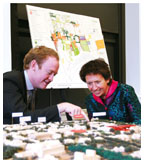
|
March 7, 2007: President's Page
THE ALUMNI WEEKLY PROVIDES THESE PAGES TO THE PRESIDENT
Alumni Trustee Matt Margolin ’05 and Charter Trustee Nancy Newman ’78 view a model of Princeton’s evolving campus during the trustee retreat. (DENISE APPLEWHITE) |
The Trustees Look Ahead
This year’s January meeting of the Board of Trustees began with a retreat that was designed to give trustees, faculty, and senior administrators an opportunity to reflect on several critical issues. Ruth Simmons, the president of Brown University and a former vice provost at Princeton, was the keynote speaker for our first session, which looked at the quality of our students’ residential experience. This discussion could not have come at a more opportune time, as we prepare to launch our new four-year residential college system next fall and as we continue to see greater geographic, ethnic, religious, and socioeconomic diversity among both undergraduate and graduate students.
Our survey data tell us that under-represented minorities and low-income students are less satisfied than other students with their lives outside the classroom. President Simmons joined the trustees in urging us to close that gap, not by attempting to homogenize the experiences of all Princeton students, but by affirming that there are multiple ways to be an integral part of Princeton’s fabric.
The trustees also focused on the importance of creating a safe environment for all students and emphasizing to incoming freshmen that Princeton is a community, and as members of that community they take on responsibilities for the well-being of one another. The Honor Code has served us well by setting very high expectations for integrity and mutual respect inside the classroom, and we need to be clear that there are similar high expectations for conduct outside the classroom.
Our second session was devoted to the campus master plan that we have been developing over the last 18 months. One of Princeton’s greatest assets is our extraordinary campus, and the trustees recognize that stewardship of the campus is one of their primary responsibilities. The discussion focused on the likely sites for growth over the next decade, including the arts neighborhood south of McCarter and Berlind theaters, the natural sciences complex that is taking shape on either side of the southern end of Washington Road, and the area around the School of Engineering and Applied Science. These locations all lie at the periphery of the campus, as it is our judgment that there are few opportunities left for “in-fill” within the central campus.
Several important themes recurred throughout the discussion. While the master plan is intended to guide us through the next decade, we need to preserve as much fl exibility as possible for future generations. We also need to think hard about the nature of the “neighborhoods” that have evolved on campus—for example, the clustering of natural science buildings along Washington Road. While the value of these functional adjacencies is clear, mixing functions within a neighborhood can encourage multidisciplinary interactions, and it can create liveliness within a neighborhood at all times of the day and night. There was a consensus that the trend toward functional neighborhoods should be tempered with some mixed use as we consider future sites for additional health, recreation, daycare, and residential buildings.
Our dinner speaker was Charles Vest, emeritus president of MIT and president-elect of the National Academy of Engineering. He talked about challenges facing our nation and its institutions of higher education, drawing upon his experiences on the Spellings Commission on the Future of Higher Education, which issued a report last fall highlighting several issues related to accessibility, affordability and accountability, and the National Academies committee that authored the report “Rising Above the Gathering Storm,” which made a compelling case for a sustained national investment in science, mathematics, and engineering education and research.
President Emeritus Gerhard Casper of Stanford University opened our final session with reflections on the impact of globalization on Princeton. It has been my experience that this is a subject of special interest to alumni, many of whom are now working and traveling on a regular basis outside the United States. President Casper began by urging us to reconsider how we organize and teach the history, languages, cultures, economies, and religions of the world on our campus. He noted that there has been a national decline in the number of regional studies departments, and he commended Princeton for sustaining such strong programs in both East Asia and the Near East.
At the same time, he and the retreat participants clearly agreed that classroom learning needs to be complemented with educational opportunities outside the United States if we are to ensure that every Princeton graduate is fully prepared to live and work in a globalized community. Now that we have largely erased the institutional and financial barriers that traditionally discouraged students from studying abroad, we need to persuade students—and their parents—of the benefits of international travel and study as part of their Princeton education.
Three issues rose to the fore: the importance of developing a rich menu of term, summer, and postgraduate opportunities for our students to conduct academic work abroad; recruiting talented foreign students and integrating them fully into the life of the University; and communicating early and often to freshmen why international study should be an integral part of their plans.
By the end of the retreat, we all had a clearer sense of where we should
direct our energies as we work to improve the quality of student life
outside the classroom, shape a campus that will serve us well for many
years to come, and strengthen Princeton’s commitment to international
education. While these are not the only major issues that we face, they
are among the most important—and well worth thinking through at
every level of our University community. ![]()


